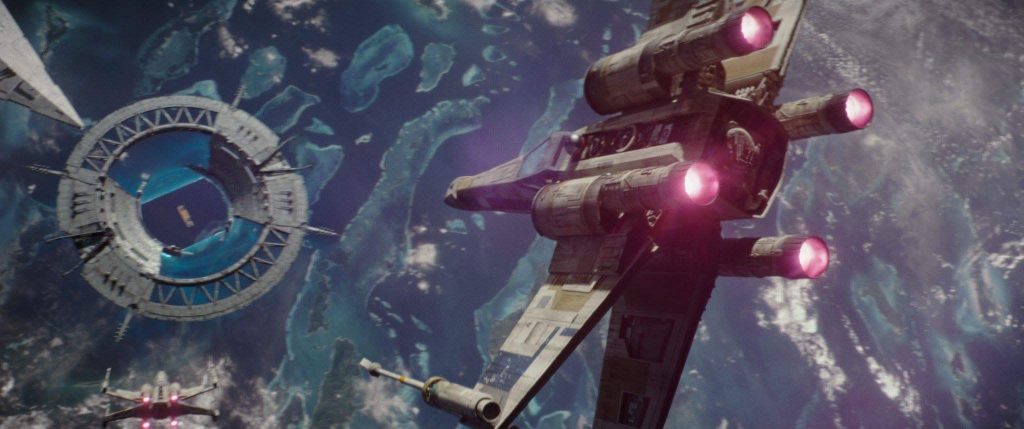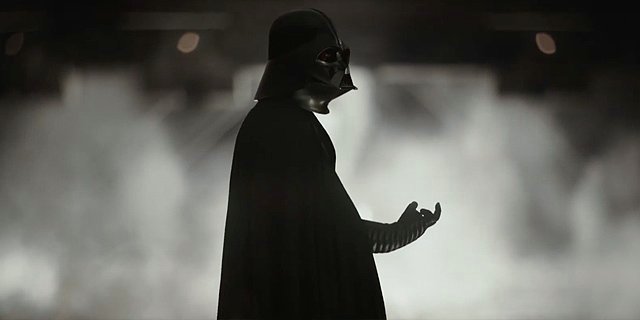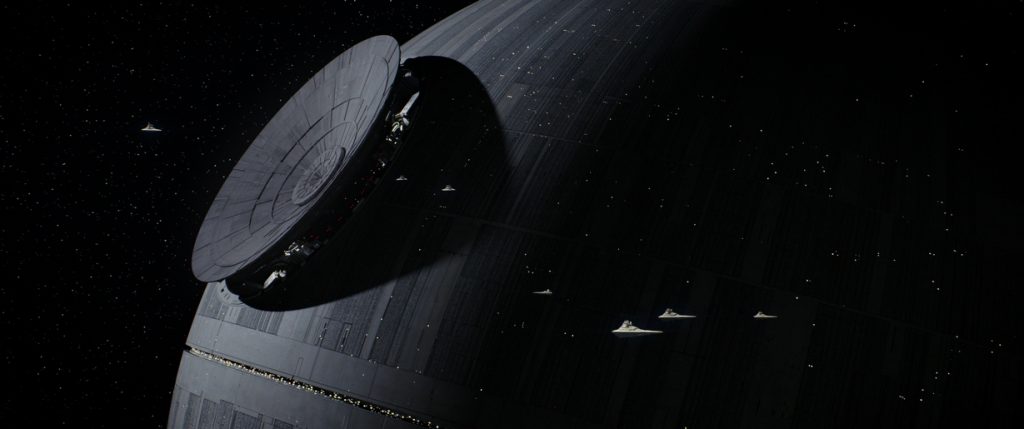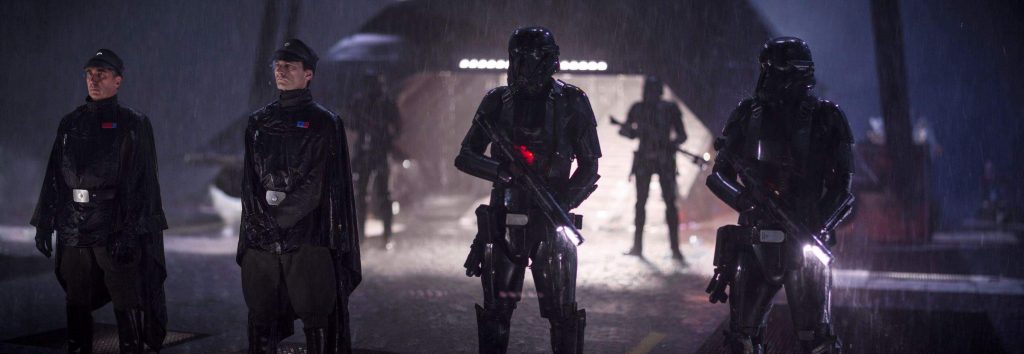 Title: Rogue One: A Star Wars Story | Rated: PG-13 | Runtime: 133 min | Theaters nationwide
Title: Rogue One: A Star Wars Story | Rated: PG-13 | Runtime: 133 min | Theaters nationwide
As things stand, a Star Wars film will officially release every year until at least 2019. The odd-numbered years will see entries that make up the sequel trilogy started by last year’s The Force Awakens, and in between, there will be films that comprise an anthology series, which tackle stories based on (so far) familiar characters and events featured in or hinted at in the trilogies. A pessimist will say that the studio is being gluttonous and on course for what may eventually led to Star Wars fatigue, which could mirror the superhero fatigue already being felt these days. On the other hand, an optimist – AKA any Star Wars fan like me – will welcome these installments with open arms. Of course, the only thing that matters is whether or not the films are any good. Not all is well with Rogue One: A Star Wars Story, but it does stand well enough on its own and indicates that there’s hope to be found in the future of the anthology films.
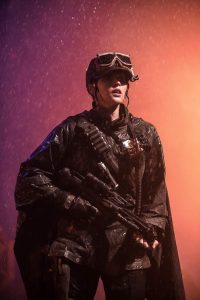 Captain Cassian Andor (Diego Luna) of the Rebel Alliance hears that an Imperial pilot named Bodhi Rook (Riz Ahmed) has defected and gone to militant resistance leader Saw Gerrera (Forest Whitaker). Rook, sent by Imperial scientist Galen Erso (Mads Mikkelsen), carries with him information regarding the Galactic Empire’s new weapon, a planet-killing space station called the Death Star. The Rebels, who aren’t on good terms with Saw, recruits Jyn (Felicity Jones), Galen’s estranged daughter whom Saw took in when she was a child, to speak to him and retrieve the information. Partnered with Cassian and reprogrammed Imperial droid K-2SO (Alan Tudyk), she heads to the Empire-occupied planet Jedha, where the trio encounters warriors Chirrut Îmwe (Donnie Yen) and Baze Malbus (Jiang Wen). As these individuals band together to find Galen and steal the Death Star plans, senior Imperial officer Orson Krennic (Ben Mendelsohn) – responsible for delivering the Death Star – becomes furious upon finding that Bodhi had been sent by someone within his own team.
Captain Cassian Andor (Diego Luna) of the Rebel Alliance hears that an Imperial pilot named Bodhi Rook (Riz Ahmed) has defected and gone to militant resistance leader Saw Gerrera (Forest Whitaker). Rook, sent by Imperial scientist Galen Erso (Mads Mikkelsen), carries with him information regarding the Galactic Empire’s new weapon, a planet-killing space station called the Death Star. The Rebels, who aren’t on good terms with Saw, recruits Jyn (Felicity Jones), Galen’s estranged daughter whom Saw took in when she was a child, to speak to him and retrieve the information. Partnered with Cassian and reprogrammed Imperial droid K-2SO (Alan Tudyk), she heads to the Empire-occupied planet Jedha, where the trio encounters warriors Chirrut Îmwe (Donnie Yen) and Baze Malbus (Jiang Wen). As these individuals band together to find Galen and steal the Death Star plans, senior Imperial officer Orson Krennic (Ben Mendelsohn) – responsible for delivering the Death Star – becomes furious upon finding that Bodhi had been sent by someone within his own team.
Rogue One stumbles quite a bit, but it eventually recovers and finishes strong. Inspired by a single line in the opening crawl of A New Hope, the story was conceived by Industrial Light & Magic’s chief creative officer John Knoll, who developed the story along with Gary Whitta. The screenplay is written by Chris Weitz and Tony Gilroy, and Lucasfilm brought on board the latter for the extensively covered reshoots. In a sense, the ending of Rogue One should surprise no one, given that its direct sequel came out back in 1977. However, the events that lead up to the climax are new (as well as canon), and Weitz and Gilroy, along with director Gareth Edwards, cover those in a busy and engaging plot. It’s apt to describe the first act as scattershot; it tries to separately introduce a bunch of characters in a short period of time by jumping back and forth between them, and the experience is made all the jarring as we’re swept across a series of locations without getting a chance to settle in. After relying on much exposition to move along (the plot is more convoluted than it needs to be), the film eventually finds its footing and explodes into an exhilarating and tightly told third act, which not only combines the thrill of a heist film with the chaos and terror of a war film, but also makes me appreciate and value the events of A New Hope. This third act is easily the best thing that the film offers, and to be honest, I would go so far to say that it’s the best third act in the entire Star Wars saga.
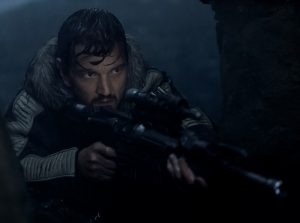 The purpose of the anthology films is to expand what we know is the limitless galaxy of Star Wars, and the film does that and then some. Most of the world-building for Star Wars nowadays comes in the form of the animated series Star Wars Rebels (of which I’ve caught a few episodes), Marvel’s Star Wars comic book series (I’ve heard nothing but praise for the Darth Vader series), and a novel here and there, so it’s great how the film takes up that task. The physical side of that expansion is realized with a number of eye-popping locations, most of which the film names at the bottom of the frame as they’re introduced. There’s the cold, green landscape of Lah’mu, the desert moon of Jedha, and the breathtaking, tropical planet that is Scarif. However, the planets don’t matter as much as the characters and what they do. We don’t just see the Rebels as the good guys and the Empire as the bad guys; at the end of the day, they still are, but there’s more shading to them. The Rebels aren’t as united as they could be, as politics threaten to divide them, nor are they exactly pure, as individuals like Cassian commit immoral acts for what believe is the greater good. We also see the extent of the Empire’s cutthroat nature among its leadership, as officers like Krennic try to one-up one another in an effort to move further up the Imperial ladder. These are by no means new concepts, but it’s great to see them unfold on screen. The film also explores the repercussions of the Galactic Civil War, showing how they affect individuals and groups across the galaxy.
The purpose of the anthology films is to expand what we know is the limitless galaxy of Star Wars, and the film does that and then some. Most of the world-building for Star Wars nowadays comes in the form of the animated series Star Wars Rebels (of which I’ve caught a few episodes), Marvel’s Star Wars comic book series (I’ve heard nothing but praise for the Darth Vader series), and a novel here and there, so it’s great how the film takes up that task. The physical side of that expansion is realized with a number of eye-popping locations, most of which the film names at the bottom of the frame as they’re introduced. There’s the cold, green landscape of Lah’mu, the desert moon of Jedha, and the breathtaking, tropical planet that is Scarif. However, the planets don’t matter as much as the characters and what they do. We don’t just see the Rebels as the good guys and the Empire as the bad guys; at the end of the day, they still are, but there’s more shading to them. The Rebels aren’t as united as they could be, as politics threaten to divide them, nor are they exactly pure, as individuals like Cassian commit immoral acts for what believe is the greater good. We also see the extent of the Empire’s cutthroat nature among its leadership, as officers like Krennic try to one-up one another in an effort to move further up the Imperial ladder. These are by no means new concepts, but it’s great to see them unfold on screen. The film also explores the repercussions of the Galactic Civil War, showing how they affect individuals and groups across the galaxy.
The heart of Star Wars lies in its eclectic characters, particularly the new ones, and with the principal group that make up Rogue One, they’re a mixed bag. The issue lies not necessarily with the characters themselves, but how the story draws and utilizes them. Jyn is capable, resourceful, smart, and tough, and her initial apathy to what’s going on in the galaxy makes her stand apart from the characters we know. Nevertheless, when it comes to her beliefs and choices over the course of the film, she’s at the mercy of the script in that it puts her in those places, so her growth doesn’t feel very organic. Cassian represents the moral murkiness of the rebellion, and his progression from a by-the-books officer to someone who acts out of his own principles plays out very well. Bodhi is fine, but it does feel like pieces of his arc are missing, and given his identity as an Imperial defector (we never see him defect, which is a missed opportunity), it’s odd how he feels more like a passenger than an active character. The chemistry between Chirrut and Baze provides an abundance of fun, though the former definitely gets much more focus than the latter. The best character is easily the blunt K-2SO, who plays for comic relief, but it says a lot when he’s so endearing. I wish that the film further develops the relationships between the characters, especially on an individual-to-individual basis, but considering that the story takes place over what is essentially 3 days, I suppose it’s understandable that they don’t fully operate as a family. Then again, A New Hope, The Force Awakens, and a film like Guardians of the Galaxy are able to do that in an equal if not shorter span of time, so make of that what you will.
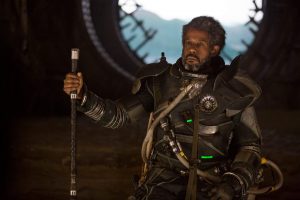 Both the new supporting characters and main villain either don’t feel like characters or are underwritten. Galen is a plot device, which is fine since he’s intrinsic to the plot, but in order to make him click as a character, we need to believe in his relationship with Jyn, which mostly comes in the form of a prologue and flashbacks where he tells her that he loves her – which is telling, not showing. It would be better for the film to feature moments that point to the type of relationship they have instead of telling us what it is so that the film can move on. Saw too is a plot device, but he’s ultimately unnecessary to the story; you can cut him out, and the film essentially loses nothing. It feels like he was shoehorned into the film just so a character from The Clone Wars animated series is here. Like Galen, he too has a history with Jyn, though it unfolds via exposition. Krennic’s personality and backstory is certainly interesting, but the script doesn’t develop him as well as it should. He lacks menace and presence, and the way he feels like a shadow of what he could have been reminds me of the character of Ultron from Avengers: Age of Ultron.
Both the new supporting characters and main villain either don’t feel like characters or are underwritten. Galen is a plot device, which is fine since he’s intrinsic to the plot, but in order to make him click as a character, we need to believe in his relationship with Jyn, which mostly comes in the form of a prologue and flashbacks where he tells her that he loves her – which is telling, not showing. It would be better for the film to feature moments that point to the type of relationship they have instead of telling us what it is so that the film can move on. Saw too is a plot device, but he’s ultimately unnecessary to the story; you can cut him out, and the film essentially loses nothing. It feels like he was shoehorned into the film just so a character from The Clone Wars animated series is here. Like Galen, he too has a history with Jyn, though it unfolds via exposition. Krennic’s personality and backstory is certainly interesting, but the script doesn’t develop him as well as it should. He lacks menace and presence, and the way he feels like a shadow of what he could have been reminds me of the character of Ultron from Avengers: Age of Ultron.
In addition to the new characters, a number of familiar ones make appearances here, and for the most part, they tend to fit in snugly. Darth Vader (voiced by James Earl Jones) is thankfully not featured prominently, but Edwards absolutely makes his scenes soar by portraying him as this ominous and terrifying force of nature. Through a combination of a live-action performance and visual effects, the film digitally resurrects Peter Cushing as Grand Moff Tarkin. He has some neat scenes with Krennic, and the details of his face are stunning, even though the creation does fall into the uncanny valley once you focus on the eyes and the way the mouth moves. If my gut instinct is right, he’s not the only character who’s brought back through digital means, but to discuss further is to veer too far into spoiler territory. Mon Mothma (Genevieve O’Reilly) and Bail Organa (Jimmy Smits) are here too, and while they don’t have much to do, it’s nice to have them in this picture to link it with both Revenge of the Sith and Return of the Jedi. In addition, two other hallmark Star Wars characters show up in a brief moment, but it’s distracting fan service that’s completely unnecessary.
 Despite some thinly drawn characters, the performances by the diverse cast are good, with some obvious standouts. It’s simply awesome that the film features this much diversity; not only are the actors great, but it serves the story well in that it shows just how the Rebel Alliance is made up of all these different groups. Jones nails Jyn’s self-confidence and headstrong disposition, and Luna handily portrays Cassian’s moral complexity with gravitas. Tudyk uses the clipped delivery of his lines for maximum humorous effect, and Yen gets much mileage out of his charisma. Ahmed injects Bodhi with much-needed emotional complexity, and for Baze, Wen finds a comfortable balance between gruff exasperation and silent affection for Chirrut. Though given a thankless role, Mikkelsen gets the job done. Whitaker’s raspy accent is evidence of his commitment to Saw, and it’s almost a shame how the film underserves the character. Mendelsohn does well with Krennic, combining a bit of honeyed charm with suppressed rage. Considering he is the one actor whose performance I was looking forward to the most in this film, that Krennic isn’t a fantastic villain pains me greatly.
Despite some thinly drawn characters, the performances by the diverse cast are good, with some obvious standouts. It’s simply awesome that the film features this much diversity; not only are the actors great, but it serves the story well in that it shows just how the Rebel Alliance is made up of all these different groups. Jones nails Jyn’s self-confidence and headstrong disposition, and Luna handily portrays Cassian’s moral complexity with gravitas. Tudyk uses the clipped delivery of his lines for maximum humorous effect, and Yen gets much mileage out of his charisma. Ahmed injects Bodhi with much-needed emotional complexity, and for Baze, Wen finds a comfortable balance between gruff exasperation and silent affection for Chirrut. Though given a thankless role, Mikkelsen gets the job done. Whitaker’s raspy accent is evidence of his commitment to Saw, and it’s almost a shame how the film underserves the character. Mendelsohn does well with Krennic, combining a bit of honeyed charm with suppressed rage. Considering he is the one actor whose performance I was looking forward to the most in this film, that Krennic isn’t a fantastic villain pains me greatly.
The anthology films present an opportunity to look and feel different from the trilogies, and Rogue One seizes it with gusto. As proven by his earlier feature films Monsters and Godzilla, Edwards is a tremendous visual storyteller, and he puts his talents to marvelous use. He captures the awe-inspiring scale of Star Wars through various means of visual language, including wide shots for jaw-dropping battle scenes, vast shadows to highlight the sizes of objects, and framing his shots in a way to highlight the size of what’s in the background in relation to what’s in the foreground. Cinematographer Greig Fraser’s work is exceptional, particularly his use of handheld cameras and close-up shots that not only lend a documentary-like feel, but also impart the grittiness and ugliness of combat. The production design by Doug Chiang and Neil Lamont shines when practical sets, populated with incredibly designed and tangible non-humans, appear in the frame. Look no further than Jedha, which combines the lawlessness of the Wild West with the look of a modern Middle Eastern war zone. What’s really nice here is the contrast between the lived-in, weathered feel of Jedha and the Imperial labor camp on Wobani with the luster of Imperial architecture found in the Death Star and Scarif. Editors John Gilroy, Colin Goudie, and Jabez Olssen have their hands full, and their work really comes to fruition in the third act, which showcases excellent cross-cutting.
 With this being a war film, there’s ample opportunity to provide a memorable and unique audial experience, and the picture generally hits its mark. There are, of course, quite a few familiar sounds that feel right at home, from the firing of blasters and thundering explosions to the screams of TIE fighters. It’s fascinating what sounds the film emphasizes, like the mechanical creaks and stomps of AT-ACTs as well as the cracking and ripping of metal. The sound design is overall excellent, and it does feature some new sounds, predominantly for creatures and never-before-seen weapons. After losing Alexandre Desplat due to scheduling issues, the film – the first in the franchise to not feature John Williams’ music – turned to Michael Giacchino to compose the score. The thing is, he had just over four weeks to do so, and it’s rather evident. His work serves the occasion well enough, but none of his tracks are memorable apart from those featuring Williams’ score. Granted, I’ve only seen the film once (in 2-D, I must add – I plan to watch it two more times over the next few days, in IMAX 3-D and IMAX 2-D 70mm), but I’ve been listening to Giacchino’s score as I write this review, and even then, I’m not particularly impressed.
With this being a war film, there’s ample opportunity to provide a memorable and unique audial experience, and the picture generally hits its mark. There are, of course, quite a few familiar sounds that feel right at home, from the firing of blasters and thundering explosions to the screams of TIE fighters. It’s fascinating what sounds the film emphasizes, like the mechanical creaks and stomps of AT-ACTs as well as the cracking and ripping of metal. The sound design is overall excellent, and it does feature some new sounds, predominantly for creatures and never-before-seen weapons. After losing Alexandre Desplat due to scheduling issues, the film – the first in the franchise to not feature John Williams’ music – turned to Michael Giacchino to compose the score. The thing is, he had just over four weeks to do so, and it’s rather evident. His work serves the occasion well enough, but none of his tracks are memorable apart from those featuring Williams’ score. Granted, I’ve only seen the film once (in 2-D, I must add – I plan to watch it two more times over the next few days, in IMAX 3-D and IMAX 2-D 70mm), but I’ve been listening to Giacchino’s score as I write this review, and even then, I’m not particularly impressed.
There are parts of Rogue One: A Star Wars Story that I really, really like, but as a whole, I can only say that it’s a good film. It’s kind of funny how its strengths and weaknesses are the opposite of those of The Force Awakens; whereas that film set strong characters against the backdrop of a familiar and safe story, this one sets underwritten characters against the backdrop of a bold and exciting story – which stutters before leading into a tremendous finale. I imagine that many moviegoers and Star Wars fans will say that Rogue One is one of the best in the saga just based on the strength of that third act, and I can’t blame them. But a third act doesn’t make the story; it’s a part of it, and for me, I – being a cinephile, critic, and unabashed Star Wars fan – have to take into account everything that comes before it. I will say, though, that I’m excited to see about the future of these anthology films. 2018, bring on the young Han solo movie!
Rating: 3.5/5.0
My updated rankings of the Star Wars films are as follows:
- Episode V: The Empire Strikes Back
- Episode IV: A New Hope
- Episode VI: Return of the Jedi
- Episode VII: The Force Awakens
- Episode III: Revenge of the Sith
- Rogue One: A Star Wars Story
- Episode I: The Phantom Menace
- Episode II: Attack of the Clones
* Photos courtesy of Walt Disney Studios Motion Pictures

